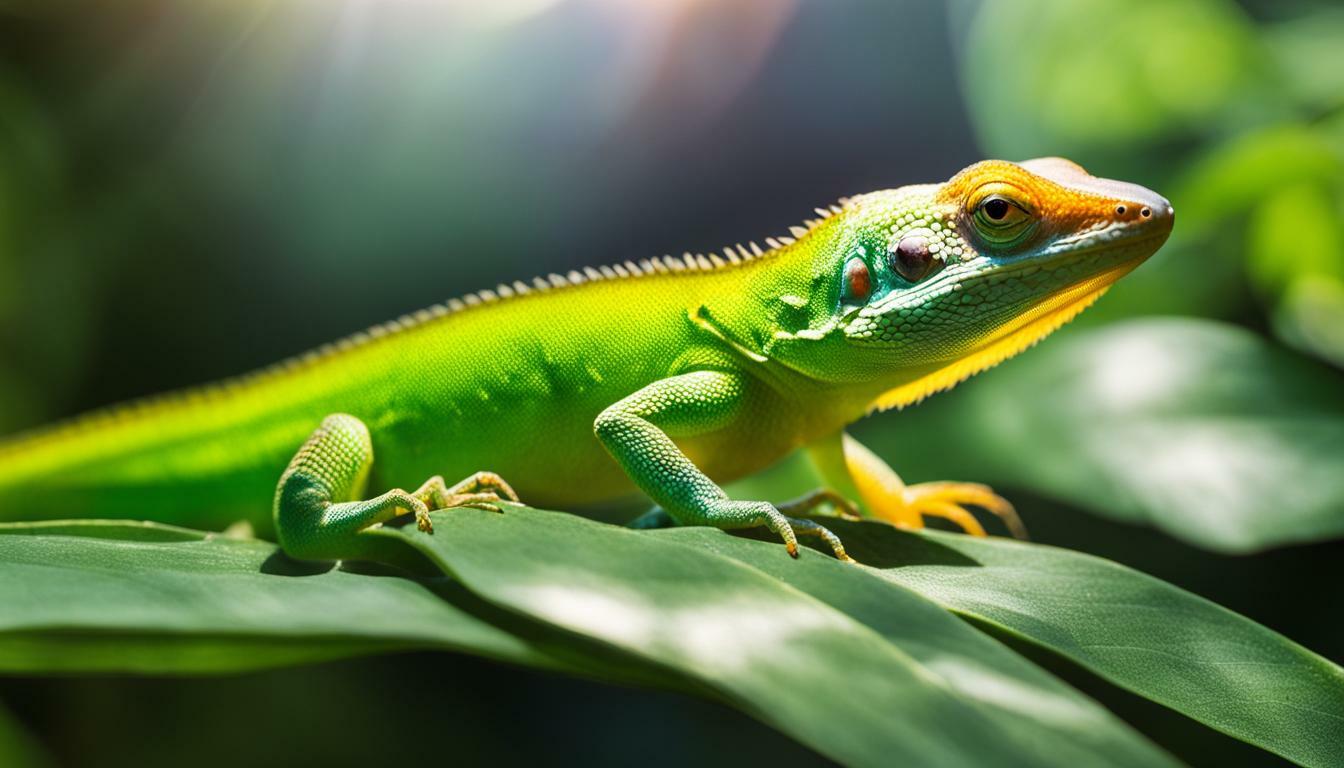Welcome to the intriguing world of the Transparent Lizard, a captivating reptile with transparent skin that allows for a glimpse into its inner workings. This unique creature has fascinated scientists and nature enthusiasts alike with its see-through appearance and remarkable adaptations.
Key Takeaways:
- The Transparent Lizard possesses transparent skin, giving it a truly unique and captivating appearance.
- It is primarily found in South and Southeast Asia, with a habitat that includes forests, grasslands, and urban areas.
- The Transparent Lizard has adapted to its environment with physical characteristics such as long limbs and a slender body.
- Its diet consists of insects, spiders, and other small invertebrates.
- The invasive species Hemidactylus frenatus poses a threat to the Transparent Lizard and other native gecko species.
Now, let’s delve deeper into the fascinating features, habitat, behavior, and threats facing the Transparent Lizard, as we unravel the mysteries of this extraordinary reptile.
Exploring the Transparent Lizard’s Features
The Transparent Lizard possesses a truly astounding feature – its transparent skin, which sets it apart from other reptiles and gives it an ethereal appearance. This remarkable adaptation allows the lizard’s internal organs and skeletal structure to be visible, providing a fascinating glimpse into its inner workings. The translucent nature of its skin also enables the lizard to seamlessly blend into its surroundings, providing it with a unique advantage in terms of camouflage.
Aside from its transparent skin, the lizard exhibits several other intriguing features. Its scales are incredibly thin and delicate, contributing to its translucent appearance. Unlike many other lizards, the Transparent Lizard lacks the vibrant colors or patterns usually associated with reptiles. Instead, it possesses a clear, almost glass-like appearance that is truly captivating.
This unique reptile is typically small in size, ranging between 5-8 inches in length. It has slender limbs and a long tail, which aids in its agility and balance. The lizard’s internal organs, such as its beating heart and pulsating arteries, can be observed through its transparent skin, offering a mesmerizing visual spectacle.
The Transparent Lizard’s remarkable features have captured the attention of scientists and reptile enthusiasts alike. In their quest to understand the evolutionary significance of its transparent skin, researchers are uncovering new insights into the complex mechanisms that enable this extraordinary reptile to thrive in its natural habitat. By unlocking the secrets of the Transparent Lizard, scientists hope to gain a deeper understanding of the intricacies of natural selection and adaptation in reptiles.
| Key Features of the Transparent Lizard | Description |
|---|---|
| Transparent Skin | The lizard’s skin is translucent, allowing for a clear view of its internal organs and skeletal structure. |
| Thin and Delicate Scales | The lizard possesses thin scales that contribute to its transparent appearance. |
| Clear Coloration | Unlike other lizards, the Transparent Lizard lacks vibrant colors or patterns, sporting a clear, glass-like appearance. |
| Small Size | The lizard measures between 5-8 inches in length and has slender limbs and a long tail. |
| Fascinating Internal Organs | The Transparent Lizard’s transparent skin provides a mesmerizing view of its pulsating heart and arteries. |
Habitat of the Transparent Lizard
The Transparent Lizard can be found in various regions, adapting to different habitats that suit its unique needs. This extraordinary reptile is known for its translucent skin, which allows it to blend seamlessly into its surroundings. Its natural range includes tropical rainforests, coastal areas, and even some arid regions.
One of the most fascinating aspects of the Transparent Lizard’s habitat is its ability to thrive in both terrestrial and arboreal environments. This versatile creature can be found climbing trees and dwelling among the branches, as well as scurrying across the forest floor. Its exceptional camouflage and agility enable it to move undetected, whether it’s on a tree trunk or amidst fallen leaves.
In terms of geographical distribution, the Transparent Lizard is predominantly found in Southeast Asia, particularly in countries like Thailand, Malaysia, and Indonesia. These areas provide the perfect combination of lush vegetation, warm temperature, and ample prey for the lizard to sustain itself.
It’s important to note that the Transparent Lizard is a native species to these regions and has evolved to thrive in their particular ecosystems. Efforts are underway to preserve and protect its natural habitats, as urbanization and deforestation pose significant threats to its survival. By raising awareness about the uniqueness and vulnerability of the Transparent Lizard’s habitat, we can contribute to the conservation of this remarkable reptile.
| Transparency Level | Prevalent Habitats |
|---|---|
| Highly Transparent | Tropical rainforests, dense vegetation |
| Semi-Transparent | Coastal areas, mangrove swamps |
| Less Transparent | Arid regions, rocky terrain |
The Behavior and Diet of the Transparent Lizard
The Transparent Lizard is a nocturnal creature, actively hunting for a wide range of insects and spiders to sustain itself. With its translucent skin, it blends seamlessly into the darkness, allowing it to move undetected as it prowls its territory. This remarkable adaptation gives the Transparent Lizard a significant advantage over its prey, making it an efficient and stealthy hunter.
Equipped with sharp claws and a lightning-fast tongue, the Transparent Lizard is a formidable predator. It uses its keen eyesight to locate its prey, relying on movement and vibrations to zero in on tasty insects scurrying in the moonlight. Once within striking distance, the lizard extends its tongue with lightning speed, capturing its unsuspecting prey in a matter of milliseconds.
In addition to insects and spiders, the diet of the Transparent Lizard may also include small reptiles and amphibians. It is not uncommon to find them feasting on the juveniles of other geckos and skinks. This opportunistic behavior allows the Transparent Lizard to take advantage of available food sources and ensures its survival in diverse habitats.
| Common Prey Species | Dietary Habits |
|---|---|
| Insects (e.g., crickets, moths) | Primary food source |
| Spiders | Supplementary prey |
| Juveniles of other geckos and skinks | Opportunistic feeding |
| Small reptiles and amphibians | Occasional predation |
The Transparent Lizard’s feeding habits play a crucial role in maintaining the delicate balance of ecosystems where it resides. By controlling insect populations, it helps to prevent outbreaks and reduce the spread of diseases. However, as with any predator, the Transparent Lizard’s success is dependent on the availability of prey and a healthy habitat.
The Threat of Invasive Species – Hemidactylus frenatus
Hemidactylus frenatus, an invasive species, poses a threat to native gecko populations due to its competitive nature and ability to displace other gecko species. Originally native to South and Southeast Asia, this gecko has expanded its distribution and established itself in numerous countries worldwide.
Measuring between 7.5-15 cm long, the common house gecko, as Hemidactylus frenatus is commonly known, displays a gray or light brown coloration with greenish iridescence and a white underside. It is sometimes semi-transparent in appearance, adding to its unique characteristics. This nocturnal hunter preys on a wide range of insects and spiders, making it a formidable predator.
Not only does Hemidactylus frenatus compete for food and habitat with native gecko species, but it also demonstrates aggression, territorial behavior, and a higher tolerance for competition. Its invasive nature enables it to out-compete and displace other geckos in urban environments, posing a significant threat to the native populations.
Efforts are underway to limit the introduction and presence of Hemidactylus frenatus in areas where it can negatively impact native gecko species. By understanding the behavior and traits of this invasive gecko, researchers and conservationists can develop strategies to control its spread and protect the biodiversity of native gecko populations.
| Threat | Impact |
|---|---|
| Competition for food and habitat | Reduction of resources for native gecko species |
| Aggression and territorial behavior | Displacement of other gecko populations |
| Tolerance for competition | Ability to out-compete native geckos |
Native gecko populations face a real and tangible threat from Hemidactylus frenatus. Conservation efforts are vital to protect these unique and valuable species from the invasive impact of this competitive gecko.
Conclusion
The Transparent Lizard, with its translucent skin and captivating presence, offers a glimpse into the wonders of nature, reminding us of the incredible diversity and adaptations within the reptile world. This remarkable creature, with its ability to camouflage and blend seamlessly into its surroundings, showcases nature’s ingenuity.
From its physical characteristics to its behavior and diet, the Transparent Lizard has evolved unique features that allow it to thrive in its natural habitat. Its transparent skin not only provides camouflage but also aids in absorbing sunlight, allowing for efficient thermoregulation. This adaptive advantage enhances its survival and endurance in various environments.
Thriving in forests, grasslands, and even urban areas, the Transparent Lizard’s geographical distribution spans across different regions. Its ability to adapt and find suitable habitats showcases its resilience and versatility as a species. However, as with many other reptiles, the Transparent Lizard faces potential threats from invasive species.
One such invader is the common house gecko, Hemidactylus frenatus. Similar in appearance to the Transparent Lizard, this gecko species poses a threat by out-competing native gecko populations for resources. Its aggressive nature and ability to adapt to urban environments have allowed it to establish itself in many countries worldwide, impacting local ecosystems.
Efforts are being made to limit the spread of invasive gecko species and protect the biodiversity of native populations. By understanding the unique qualities of the Transparent Lizard and raising awareness about the threats posed by invasive species, we can work towards preserving the delicate balance within our ecosystems and appreciating the beauty of these remarkable reptiles.
FAQ
Q: What is the common house gecko?
A: The common house gecko, also known as Hemidactylus frenatus, is a gecko species native to South and Southeast Asia.
Q: What is the size and coloration of the common house gecko?
A: The common house gecko measures between 7.5-15 cm long and has a gray or light brown coloration with greenish iridescence and a white underside. It is sometimes semi-transparent in appearance.
Q: What does the common house gecko eat?
A: The common house gecko primarily preys on a wide range of insects and spiders. It also consumes juveniles of other geckos and skinks, as well as sugar-based products and nectar.
Q: Where can the common house gecko be found?
A: The common house gecko has expanded its distribution beyond its native range and is now established in many countries around the world.
Q: How does the common house gecko impact native gecko species?
A: As an invasive species, the common house gecko poses a threat to native gecko species by out-competing them for food and habitat. It is more aggressive, territorial, and tolerant of competition than native geckos.
How Does a Transparent Lizard’s Vision Work?
The intricacies of lizard vision explained reveal a fascinating process. Transparent lizards possess specialized cells in their retina that allow them to see ultraviolet light. This unique ability helps them communicate, hunt, and find mates. By understanding how their vision works, scientists gain insights into the remarkable adaptations of these remarkable creatures.


One thought on “Transparent Lizard”